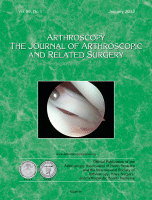Warmed Irrigation Fluid Does Not Decrease Perioperative Hypothermia During Arthroscopic Shoulder Surgery
Arthroscopy: The Journal of Arthroscopic and Related SurgeryVolume 30, Issue 2 , Pages 159-164, February 2014
Joo Han Oh, M.D., Ph.D., Joon Yub Kim, M.D., Seok Won Chung, M.D., Ji Soon Park, M.D., Do Hun Kim, M.D., Sung Hoon Kim, M.D., Mi Ja Yun, M.D., Ph.D.
Setting and objective:
- This was a level I randomized control trial to compare the clinical efficacy of warmed irrigation fluid with room temperature fluid in the setting of arthroscopic rotator cuff surgery.
- It is an established fact that the irrigation fluid used in arthroscopy can lead to hypothermia.
- Hypothermia which is defined by a core body temperature of less than 36°C, can cause the following : postoperative shivering; cardiac morbidity, which impairs oxygen delivery to the tissue; delay in recovery from anesthesia; blood loss; coagulopathy; and wound infection.
- Some authors had recommended use of warmed irrigation fluid to prevent hypothermia.
Materials and Methods:
Patients: 72 patients undergoing arthroscopic rotator cuff surgery were randomized in to 2 groups.
Intervention-Group 1 – 36 patients received warmed irrigation fluid (36° C) during surgery
Control- Group 2 – 36 patients received room temperature fluid. No Intraoperative warming devices were used.
Outcome Measurements: An esophageal stethoscope with a thermometer and a tympanic thermometer were used to measure the serial core body temperature and the last and lowest core body temperature at 15-minute intervals during surgery and the recovery period.
Other measurements: After recovery, patients were warmed and were monitored for hypothermia related adverse events (shivering, cardiac events). Hemoglobin and visual analog scores were recorded immediately after surgery and on postoperative day 1. Changes in patients’ weight and prothrombin time were also assessed on the 1st postoperative day.
Results: The core body temperatures decreased serially during surgery and increased linearly post recovery and there was no difference between the 2 groups (P > .05). The incidence of Intraoperative hypothermia was similar between the 2 groups (34/36 in group 1 and 33/36 in group 2, P = .276). There was no difference in postoperative adverse events. The 2 groups did not differ in postoperative weight change, hemoglobin level, prothrombin time and visual analog scores (P >.05).
Conclusions: There is no superiority with warmed irrigation fluid in reducing intraoperative hypothermia and postoperative hypothermia related adverse events compared to room temperature fluid during arthroscopic rotator cuff surgery.
Study Limitations: No standard temperature has been set for irrigation fluid, different methods used for assessing core body temperature (esophageal stethescope, digital tympanic thermometer)
Ref:
http://www.arthroscopyjournal.org/article/S0749-8063(13)01243-7/abstract

Leave a Reply